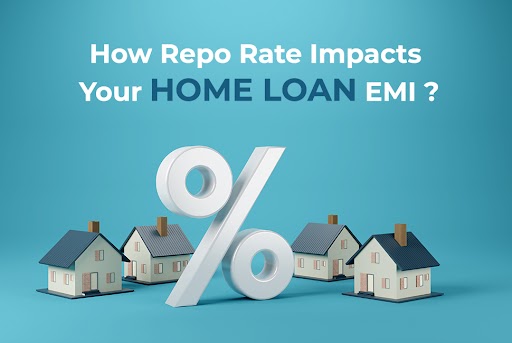Blog Details

How RBI Repo Rate Impacts Your Home Loan EMI – Explained with Examples
The Reserve Bank of India (RBI) uses the Repo Rate as a key tool to control inflation and manage liquidity in the economy. But what does this mean for you as a homebuyer? Quite a lot, actually. Even a small change in the repo rate can impact your monthly EMI and total loan cost significantly.
What is the Repo Rate?
The Repo Rate is the interest rate at which the RBI lends money to commercial banks. When the repo rate increases, borrowing becomes expensive for banks and they pass this cost on to customers. Conversely, a reduction in the repo rate can make loans cheaper for consumers, reducing EMIs.
How Does Repo Rate Work?
The repo rate, short for repurchase rate, refers to the interest rate at which the Reserve Bank of India (RBI) lends money to commercial banks against government securities. It plays a vital role in regulating liquidity, controlling inflation, and supporting economic growth.
When the RBI changes the repo rate, it directly impacts the cost of borrowing for banks. This, in turn, affects the loan and deposit interest rates offered to consumers. By increasing or decreasing the repo rate, the central bank aims to stabilize the economy, keep inflation in check, and encourage sustainable growth.
Why is Repo Rate Important?
The repo rate, determined by the Reserve Bank of India (RBI), plays a pivotal role in shaping the country’s monetary policy. It directly influences the cost of borrowing and the overall liquidity in the financial system.
When the repo rate is increased, it becomes more expensive for commercial banks to borrow from the RBI. As a result, banks raise their lending rates, making loans costlier for consumers. This discourages excessive borrowing, reduces spending, and helps control inflation. Conversely, a lower repo rate makes borrowing cheaper, encouraging business investments and consumer spending, which stimulates economic growth.
As interest rates fluctuate with changes in the repo rate, using a loan calculator becomes essential for individuals to estimate their EMIs and understand the impact of rate changes on their loan repayment plans.
The Monetary Policy Committee (MPC) of the RBI is responsible for setting the repo rate. It serves as a key instrument to regulate inflation, manage liquidity, and ensure economic stability.
How Repo Rate Affects Home Loan EMI
Most home loans today are linked to external benchmarks such as the RBI’s Repo Rate, which means changes in the repo rate directly affect the interest rate on your loan.
Formula for EMI:
EMI = \frac{P \times r \times (1 + r)^n}{(1 + r)^n - 1}
Where:
• P = Loan Amount
• r = Monthly Interest Rate
• n = Loan Tenure in Months
Example 1: Repo Rate Cut by 0.25%
Let’s say the RBI cuts the repo rate by 0.25%. Here’s the impact on a ₹75 lakh home loan over 20 years:
Parameter Before (9%) After (8.75%)
- Loan Amount ₹75,00,000 ₹75,00,000
- Tenure 20 years 20 years
- EMI ₹67,478 ₹66,278
- Monthly EMI Savings — ₹1,200
- Total Interest Saved — ₹2.81 lakh approx.
Example 2: Repo Rate Cut by 0.50%
Now suppose RBI reduces the rate by 0.50%:
Parameter Before (9%) After (8.5%)
- EMI ₹67,478 ₹65,096
- Monthly EMI Savings — ₹2,382
- Total Interest Saved — ₹5.71 lakh approx.
Example 3: Repo Rate Increase by 0.25%
Now let’s see the reverse situation. If RBI increases the repo rate:
Parameter Before (9%) After (9.25%)
- EMI ₹67,478 ₹68,692
- Monthly EMI Increase — ₹1,214
- Total Extra Interest Paid — ₹2.91 lakh approx.
How Quickly Does the Change Reflect in Your EMI?
Since October 2019, most banks offer repo rate-linked loans, which are revised at least once every 3 months. So, if RBI changes the rate, your loan’s interest rate could be revised within the same quarter.
Final Thoughts
In conclusion, the Repo Rate plays a vital role in the Reserve Bank of India’s strategy to control inflation and ensure overall economic stability. By adjusting the rate, the RBI either tightens or eases monetary policy in response to inflationary trends. These changes directly influence borrowing costs, including interest rates on loans such as home loans. At Loan Quantum, we help users stay informed about these fluctuations, empowering smarter financial decisions based on current Repo Rate trends.
Even a 0.25% change in the repo rate can have a significant impact on your finances over the long term. It’s wise to stay updated on RBI’s announcements and review your home loan options regularly. If the repo rate drops, consider refinancing your loan to enjoy lower EMIs or reduce your tenure.
Would you like this converted into a blog post with visuals (charts or infographics), or published to your company’s website like LoanQuantum?
Frequently Asked Questions
No, fixed-rate loans stay the same even if the repo rate changes. However, you could get a better deal by refinancing at a lower interest rate.
Yes, a drop in interest rates lowers borrowing costs, making home loans more affordable and attractive for first-time buyers.
The timeline depends on the lender, but most banks usually take anywhere from a few weeks to a couple of months to revise their lending rates.
When the interest rate drops from 8.75% to 8.50%, the EMI on a ₹50 lakh loan over 20 years can reduce by nearly ₹795 each month.
If your current loan carries a much higher interest rate, switching to a lower-rate loan through refinancing can lead to significant long-term savings.
If your loan has a floating interest rate tied to the repo rate, your EMI could reduce in the near future—subject to your lender’s terms and conditions.
Although rate changes usually follow, banks also evaluate factors such as their cost of funds before revising interest rates.